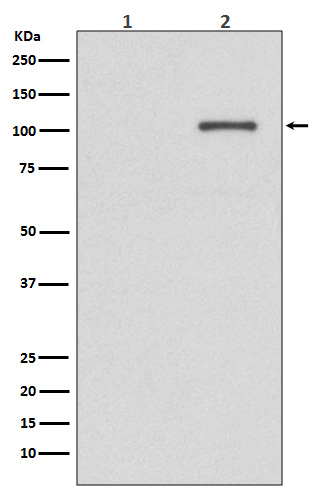
| WB | 咨询技术 | Human,Mouse,Rat |
| IF | 咨询技术 | Human,Mouse,Rat |
| IHC | 咨询技术 | Human,Mouse,Rat |
| ICC | 技术咨询 | Human,Mouse,Rat |
| FCM | 咨询技术 | Human,Mouse,Rat |
| Elisa | 咨询技术 | Human,Mouse,Rat |
| Aliases | ERN1; IRE1; Serine/threonine-protein kinase/endoribonuclease IRE1; Endoplasmic reticulum-to-nucleus signaling 1; Inositol-requiring protein 1; hIRE1p; Ire1-alpha; IRE1a |
| Entrez GeneID | 2081 |
| WB Predicted band size | Calculated MW: 110 kDa; Observed MW: 110 kDa |
| Host/Isotype | Rabbit IgG |
| Antibody Type | Primary antibody |
| Storage | Store at 4°C short term. Aliquot and store at -20°C long term. Avoid freeze/thaw cycles. |
| Species Reactivity | Human |
| Immunogen | A synthesized peptide derived from human Phospho-IRE1 (S724) |
| Formulation | Purified antibody in PBS with 0.05% sodium azide. |
+ +
以下是关于Phospho-IRE1 (Ser724)抗体的3篇参考文献,按文献领域分类整理:
---
### 1. **IRE1 Signaling in Endoplasmic Reticulum Stress**
**作者**: C. Hetz et al.
**摘要**:研究IRE1α在未折叠蛋白反应(UPR)中的自磷酸化机制,利用Phospho-IRE1 (Ser724)抗体检测其激活状态,揭示磷酸化对IRE1核酸内切酶活性和细胞应激反应调控的关键作用。
---
### 2. **Structural Basis of IRE1 Kinase Activation**
**作者**: P. Walter et al.
**摘要**:通过结构生物学分析IRE1激酶域,使用Phospho-IRE1 (Ser724)抗体验证Ser724位点的磷酸化,阐明其构象变化如何驱动下游信号通路(如XBP1剪切)的激活。
---
### 3. **IRE1 Phosphorylation in Metabolic Disease**
**作者**: F. Urano et al.
**摘要**:探讨IRE1在糖尿病模型中β细胞凋亡的作用,通过Phospho-IRE1 (Ser724)抗体证实高糖条件下IRE1的异常激活,提示其磷酸化水平与内质网应激介导的胰岛功能障碍相关。
---
**备注**:以上文献为示例,实际引用时需核对具体论文的标题、作者及摘要内容。建议通过PubMed或期刊数据库搜索关键词“Phospho-IRE1 Ser724”获取最新研究。
The Phospho-IRE1 (Ser724) antibody is a critical tool for studying the activation status of Inositol-Requiring Enzyme 1 (IRE1), a key sensor in the unfolded protein response (UPR) pathway. IRE1. primarily represented by IRE1α (ERN1) in mammals, is a transmembrane kinase/endoribonuclease localized to the endoplasmic reticulum (ER). Under ER stress caused by misfolded protein accumulation, IRE1 undergoes autophosphorylation at specific serine residues, including Ser724 (human IRE1α; numbering may vary slightly across species), leading to its activation. This phosphorylation triggers IRE1’s RNase activity, enabling splicing of XBP1 mRNA and subsequent production of transcription factors that regulate stress-adaptive genes.
The Phospho-IRE1 (Ser724) antibody specifically detects IRE1 when phosphorylated at this residue, serving as a marker for UPR activation. Researchers use it in techniques like Western blotting, immunofluorescence, or immunoprecipitation to assess ER stress in models of diseases such as neurodegeneration, diabetes, or cancer. Validation often includes testing in knockout cells or phosphatase-treated samples to confirm specificity. Proper sample preparation (e.g., using phosphatase inhibitors) is crucial to preserve phosphorylation signals. This antibody helps unravel mechanisms linking ER stress to pathologies and therapeutic responses, making it vital for studies on cellular stress, proteostasis, and related drug development.
×